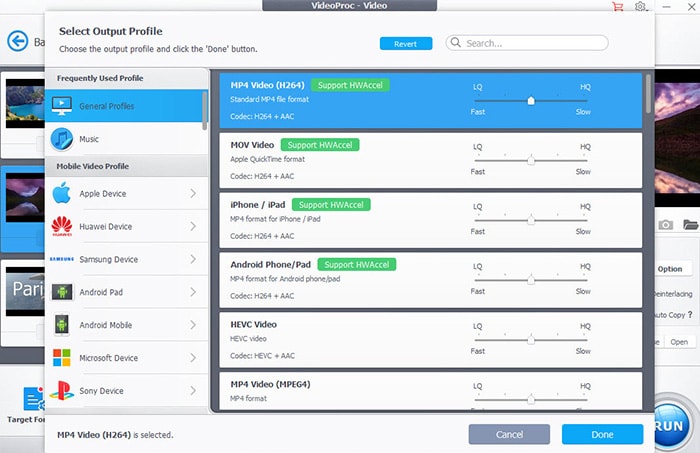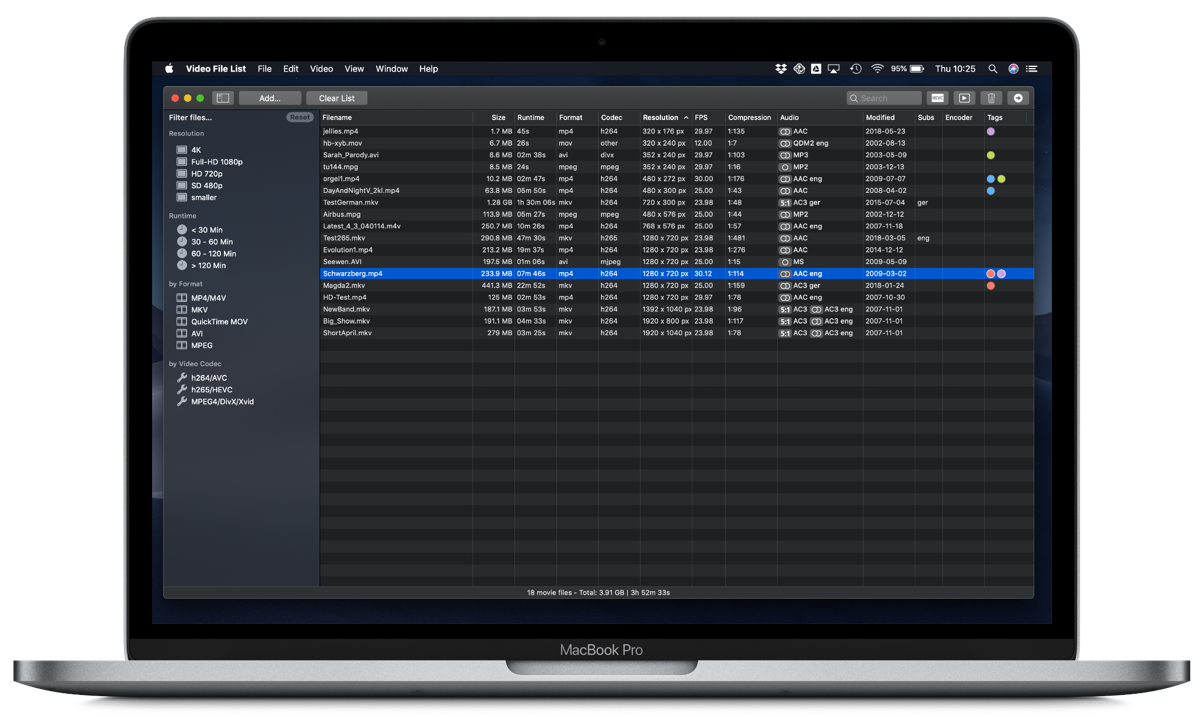'What video format does iMovie support?' When using iMovie, you need to concern about what format you can import and export. So you must want to know the best iMovie video formats and audio formats. You might partially know that iMovie support MPEG-4, MPEG-2, DV, MOV and M4V formats, but you should know the details to avoid any incompatible issues. In this article, we will share detailed tips on what file formats are supported by iMovie.
Part 1. The Best iMovie Alternative to Support More File Formats- Filmora Video Editor
Windows Media files (.wmv,.wma) aren't supported on PowerPoint 2016 for Mac or PowerPoint for Microsoft 365 for Mac. There are a number of 3rd party tools for Mac that can convert your.wmv or.wma file to one of the supported formats listed above. When it comes to the best video players for Mac, VLC is the longtime king. This free, lightweight, open source cross-platform media player is powerful enough to cope with most video formats including MPEG, WMV, MP4, MKV, MOV, and AVI. The player can play almost everything on a single platform from DVDs, and audio CDs to streams and webcams. H.264 video up to 1080p, 30 fps, Main Profile level 3.1 with AAC-LC audio up to 160 Kbps, 48kHz, stereo audio in formats like.mp4.mov and.m4v; Motion JPEG (M-JPEG) up to 35 Mbps, 30 fps, 1280 x 720 pixels, audio in ulaw, PCM stereo audio in.avi format. IPad Supported Audio Format: - HE-AAC (V1 and V2).
Filmora Video Editor for Mac (or Filmora Video Editor) is the best iMovie alternative for Mac to edit videos. It not only supports all the file formats for iMovie, but also support importing almost any video, auido, and images formats, and exporting videos in multiple formats according to your needs. With it, you'll never worry about the video incompatibility issue. What's more, all editing features it provideos as iMovie allows you to. Just feel free to import any video, audio or images and export videos to play on smartphones, iPhone, iPad, and other great tablets.
What Is The Best Video Format For Mac
Filmora Video Editor Supported Formats
* Import formats list of Filmora Video Editor
Filmora Video Editor supports multiple import file formats and methods. You can import media files not only from local Mac or Windows, but also from iPhone, iPad, Android, camcorder, cameras and many other devices, as well as from Facebook and other social platforms. You can even directly record videos from webcam or vioceover through the program.

* Export formats list of Filmora Video Editor
What Video Format Does Mac Use
Your experience when exporting files with Filmora Video Editor for Mac will be the best since it supports a variety of formats. When exporting video, you can look up to formats like EVO, TOD, NSV, MOD, MKV, F4V, WMV, TRP, MTS and M2TS among others. Filmora Video Editor is also good for audio files export and will be supported by formats like MP2, MKA, FLAC, AU, APE, AIF and AC3. It will be upon you to choose the right file that is suitable for exporting your video or audio file in the best way.

Part 2. iMovie Supported Video Formats for Importing
You will have the privilege of choosing from several iMovie formats supported to deal with any incompatibility concerns. However, you should be able to differentiate between formats for video and audio. Any mix-up will cause incompatibility which is the last thing you would want to experience when using iMovie. First, I want to ensure you that all videos generated by Apple products, like recorded by iPhone and iPad, will be fully supported by iMovie. As for other video formats, it depends. You can check the iMovie supported video list below to see whether your videos are supported or not (both for import and export).
The below sheet lists out iMovie supported video format:
Besides all mentioned video formats for iMovie above, there could be other formats in the market but these ones are the common ones for importing files on iMovie. However, you should not waste time looking for the best video format for iMovie because all of them have different features and perform differently making it possible to decide on which is the best. All of them have equal strengths and weaknesses so just look for the suitable and compatible one to use.
Various Video Formats
Part 3. iMovie Supported Video Formats for Exporting
It will be easier for you to decide on exporting files to iMovie but choosing the right format might be challenging. This is because there are many options available but this part will discuss some of the commonly used formats. You can use them the next time you are planning to export audio and video files to iMovie.
Over and above, you can do some advanced research and you will come across additional file formats that are as good as those discussed above. Do you know that it is possible to have settings for these exports formats in iMovie customized? Yes, that is possible and you are advised to consider that in making your experience more enjoyable. This will be in relation to frame rate, frame size and key frames among many other applicable settings.
When customizing your export video format for iMovie settings, the frame size should be done first followed by key frames and then conclude with frame rate. That is the standard procedure used in making sure nothing goes astray. The right settings should be able to offer the best compromise between qualities of the video playback and file size. That has to be the foundation for adjusting settings for your iMovie export format all the time.
From .WEBM, .OGG, .MP3, .MP4 and more, there are many video file formats you can expect to come across as a developer handling audio/video content in your application. Like in our last article The Complete Image File Extension List for Developers, and How to Choose the Best Audio File Format and Codec, in this article we’ll delve into the different types of audio/video file types, and when to use which type of audio or video format for your application.
First, let’s get a couple of common questions out of the way:

Which is the best video format?
Unfortunately, there is no single “best” video format. The best video format for you depends on how you would like to balance the quality and size of the video file. Some formats are extremely small and are great for web video streaming, but are low quality. Other formats are high quality and the right choice for commercial videography but are very large in size.
What is the difference between a video codec, video container, and a video file format?
Video files are made of 2 parts: a codec and a container.
A video codec is a protocol for encoding and decoding video (the word codec comes from “enCOde / DECode”). Common codecs include H.264, MPEG-4, and DivX. A well-engineered codec has high efficiency, or ability to preserve quality while reducing file size.
The container format is a definition of how the file metadata and data are structured, excluding how the video is actually encoded (which the codec determines). The container file holds the metadata and compressed video data which is encoded using the codec. The container format is also more generally called “the format”, and is reflected in the file’s extension. Common container formats include .AVI, .MP4, and .MOV. Container formats can be paired with different codecs that influence what devices and programs the file will be compatible with.
Which file format is my video file?
On Mac, right-click the video file and click “Get Info”, then under “More Info” you should see both the video and audio codec.
On Windows, right-click the file and click “Properties”. Under the “Details” tab you will see the file format and codecs used.
Which video format is the smallest?
As of now, the HEVC or H.265 codec is one of the most efficient available on the market and is commonly used to compress 8K UHD video. However, using the codec requires paying a licensing fee so it is not widely compatible or supported by devices or browsers. On the web, .WEBM and its corresponding VP8/VP9 codec are a widely compatible and popular way of making video files smaller.

However, it’s important to consider factors besides size: where the files will be played and the required quality of the video. Next, we’ll dive into each of the most popular container formats to understand the tradeoffs.
Video File Formats
.WEBM
Like the .WEBP image file, .WEBM was created by Google as an efficient means of disseminating media to a large audience. .WEBM video files are relatively small in size, and as such are not as high in terms of quality as some of the other file types on this list. The .WEBM video file format is used for HTML5 video streaming sites, such as YouTube.
.MPG, .MP2, .MPEG, .MPE, .MPV
.MPG, .MP2, .MPEG, .MPE, .MPV files can play audio/video media, or simply audio. They are low in file size but also relatively low in quality. They also have lossy compression, meaning their quality will degrade after being edited numerous times. .MPG, .MP2, .MPEG, .MPE, .MPV files are best used when video will be recorded once and never edited.
.OGG
.OGG files are an open-source alternative to .MPG files, and are used for high-quality videos to be streamed via the internet. Though .OGG files are used for streaming, they are higher in quality than .WEBM files – meaning they will take longer to be delivered to the end-user. Due to .OGG files being open sourced, they can be used in a variety of applications, including GPS receivers and media players (both desktop and portable).
.MP4, .M4P, .M4V
.MP4, .M4P, .M4V are similar to .MPG files in that they can contain audio and video, or can simply be solely audio files. Their file formats are lossless, which makes them ideal for editing as they won’t lose quality through subsequent edits and file saves. .MP4, .M4P, and .M4V are used for streaming video via the internet. They are generally higher in quality than .WEBM files, but tend to be larger in file size. .M4V files are proprietary iTunes files that share the same qualities of .MP4 and .M4P files. M4V files are DRM copy-protected.
.AVI
.AVI files are one of the oldest and most compatible video file formats. Many different codecs can be used with an .AVI file, which means that this format has more flexibility in choosing a balance between quality and size. However, these files tend to be larger than the previously mentioned formats, which makes it less ideal for the web and more ideal for storing movies on a computer.
.WMV
.WMV is a video file format created by Microsoft and stands for Windows Media Video. The codec used by these files results in small file sizes but poor quality. This format is useful if you are sending video to someone with an older Windows computer.
.MOV, .QT
.MOV and .QT files were developed by Apple to use with its Quicktime player. These files are of high quality but large in size. And they have poor compatibility with non-Quicktime players. This format is useful if you intend to archive a high-quality video on an Apple computer.
.FLV, .SWF
.FLV and .SWF files were designed by Adobe as the video file format for Flash. The use of these file formats has declined rapidly as Flash has become less popular, especially after Flash support ended for iOS devices. The use of these formats is only recommended if you need to support a legacy system that can only accept this type of file.
AVCHD
AVCHD or Advanced Video Coding High Definition files are the format generated by many digital camcorders. These files use the H.264/MPEG-4 video codec and are similar to an .MPG file.
How to choose the best video file format
Choosing the right video file format depends entirely on what you plan on using the video for. You should choose a format that achieves the quality of video you require, but nothing more. Unnecessarily high-quality video files can be unwieldy to move, share, convert, and manage. In addition, how the video files will be viewed is important. Not all programs, browsers, and devices can open a specific video format. Consider a couple of scenarios:
- If the video will be viewed on the web, choose a format that is supported by most browsers. This way, your video will be able to be played without downloading the file and using a separate player. Browser compatible video formats include MP4 and WEBM.
- If you are archiving a home video, choose a format that is high quality and has a good chance of being playable in the future. Open source formats are more future-proof than proprietary formats that are controlled by a specific company. Formats that fit this category are MP4 or AVI (using an open codec).
- If you work at a company that uses older Windows computers, you should choose a format that is highly compressed and compatible with Windows. In this case, you’d want to use a WMV file.
Conclusion
In summary, the most common video file types are:
- .WEBM
- .MPG, .MP2, .MPEG, .MPE, .MPV
- .OGG
- .MP4, .M4P, .M4V
- .AVI, .WMV
- .MOV, .QT
- .FLV, .SWF
- AVCHD
How to convert video file formats
There are certain times when it is best to use one file format over another, and often, you have to convert between file formats. To programmatically convert between audio or video file types, you can use Filestack’s audio andvideo transcoding API. Filestack’s API also supports extracting audio files from video files, cropping or resizing video files, extracting thumbnails from videos, and more. Get started for free with Filestack today.

Read More →
